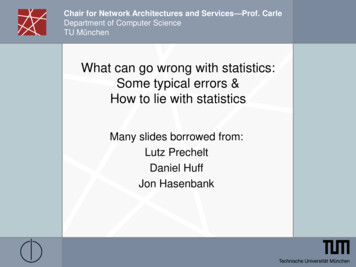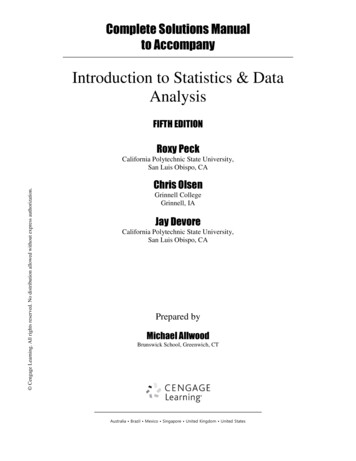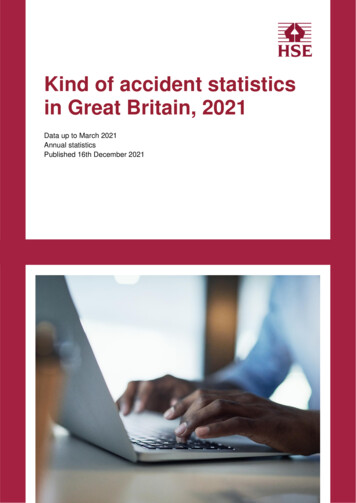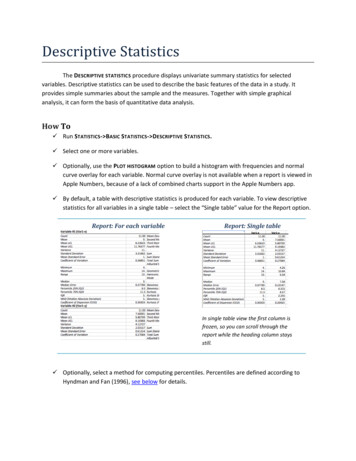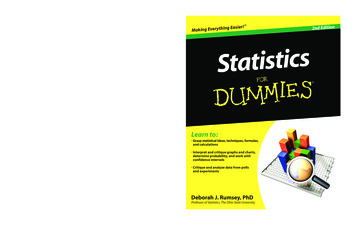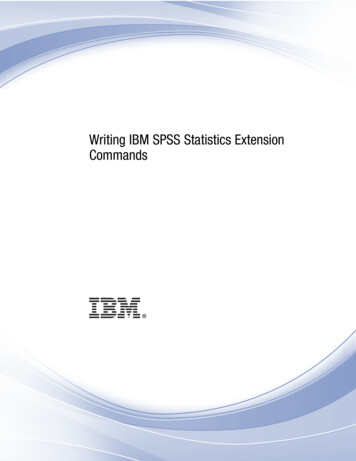
Transcription
MathematicsStatistics
2Letter to Families from the DPSCD Office of MathematicsDear DPSCD Families,The Office of Mathematics is partnering with families to support Distance Learning while students arehome. We empower you to utilize the resources provided to foster a deeper understanding of gradelevel mathematics.In this packet, you will find links to videos, links to online practice, and pencil-and-paper practiceproblems. The Table of Contents shows day-by-day lessons from April 14th to June 19th. Weencourage you to take every advantage of the material in this packet.Daily lesson guidance can be found in the table of contents below. Each day has been designed toprovide you access to materials from Khan Academy and the academic packet. Each lesson hasthis structure:Watch: Khan Academy (ifinternet access is available)Practice: Khan Academy (if internetaccess is available)Pencil & Paper Practice:Academic PacketWatch and take notes on thelesson video on Khan AcademyComplete the practice exercises onKhan AcademyComplete the pencil and paperpractice.If one-on-one, live support is required, please feel free to call the Homework Hotline at 1-833-4663978. Please check the Homework Hotline page for operating hours. We have DPSCD mathematicsteachers standing by and are ready to assist.We appreciate your continued dedication, support and partnership with Detroit Public SchoolsCommunity District and with your assistance we can press forward with our priority: OutstandingAchievement. Be safe. Be well!Tony R. HawkDeputy Executive Director of K-12 MathematicsPrinted problems in this packet come from the CPM Educational Program. Open eBook access is available at http://open-ebooks.cpm.org/. 2009, 2014 CPMEducational Program. All rights reserved.
3Important Links and InformationCleverStudents access Clever by visiting www.clever.com/in/dpscd.What are my username and password for Clever?Students access Clever using their DPSCD login credentials. Usernames and passwords followthis structure:Username: studentID@thedps.orgEx. If Aretha Franklin is a DPSCD student with a student ID of 018765 her username would be018765@thedps.org.Password:First letter of first name in upper caseFirst letter of last name in lower case2-digit month of birth2-digit year of birth01 (male) or 02 (female)For example: If Aretha Franklin’s birthday is March 25, 1998, her password and passwordwould be Af039802.Accessing Khan AcademyTo access Khan Academy, visit www.clever.com/in/dpscd. Once logged into Clever, selectthe Khan Academy button:Printed problems in this packet come from the CPM Educational Program. Open eBook access is available at http://open-ebooks.cpm.org/. 2009, 2014 CPMEducational Program. All rights reserved.
4Accessing Your CPM eBookStudents can access their CPM eBook in two ways:Option 1: Access the eBook through Clever1. Visit www.clever.com/in/dpscd. Login using your DPSCD credentials above.2. Click on the CPM icon:Option 2: Visit http://open-ebooks.cpm.org/1. Visit the website listed above.2. Click “I agree”3. Select the CPM Statistics eBook:Desmos Online Graphing CalculatorAccess to a free online graphing and scientific calculator can be found athttps://www.desmos.com/calculator.Printed problems in this packet come from the CPM Educational Program. Open eBook access is available at http://open-ebooks.cpm.org/. 2009, 2014 CPMEducational Program. All rights reserved.
5Table of ContentsIn the following table, you will find the table of contents and schedule for the week of April 13, 2020through the week of June 15, 2020.WeekTopicWatch(10 minutes)Online Practice(10 minutes)Pencil &PaperPractice(25minutesHolidayN/AN/AN/A5.1.1 RelativeFrequencyHistogramsand RandomVariablesRelative FrequencyHistograms and DensityCurvesProperties of DensityCurvesMultipleChoice 110 andFreeResponse1-3Intro to DensityFunctionsProperties of DensityCurvesDay 25.1.2Introduction toDensityFunctionsThe NormalProbability DensityFunctionThe Normal ProbabilityDensity FunctionDay 35.1.3 TheNormalProbabilityDensityFunction5.2.1 TheInverse NormalFunctionThe Inverse NormalFunctionThe Inverse NormalFunction5.2.2 TheStandardNormalDistributionand Z-ScoresThe Standard NormalDistribution and zScoresThe Standard NormalDistribution and zScoresDateMonday,4/13/20Day 1Week of4/14 –4/17Day 4Week 2Day 1Printed problems in this packet come from the CPM Educational Program. Open eBook access is available at http://open-ebooks.cpm.org/. 2009, 2014 CPMEducational Program. All rights reserved.
6Day 25.2.3AdditionalPracticeProblemsThe Standard NormalDistribution and zScoresThe Standard NormalDistribution and zScoresChapter 5ClosureKhan AcademyPractice TestKhan AcademyPractice Test6.1.1 Meanand Varianceof a DiscreteRandomVariableMean and Varianceof a Discrete RandomVariableMean and Variance ofa Discrete RandomVariable6.1.2 sforming RandomVariablesTransforming RandomVariables6.1.3Exploring theVariability of X XExploring theVariability of X X6.2.1Introducingthe BinomialSettingIntroducing theBinomial SettingIntroducing theBinomial Setting6.2.2 BinomialProbabilityDensityFunctionBinomial ProbabilityDensity FunctionBinomial ProbabilityDensity FunctionDay 3Day 4Day 5Day 1Exploring theVariability ofMultipleChoice 110 andFreeResponse1-3𝑋 𝑋Week 3Day 2Day 3Printed problems in this packet come from the CPM Educational Program. Open eBook access is available at http://open-ebooks.cpm.org/. 2009, 2014 CPMEducational Program. All rights reserved.
76.2.3 ExploringBinomial pdfand cdfExploring Binomial pdfand cdfExploring Binomial pdfand cdf6.2.4 Shape,Center, andSpread of theBinomialDistributionShape, Center, andSpread of theBinomial DistributionShape, Center, andSpread of the BinomialDistribution6.2.5 NormalApproximationto the BinomialDistributionNormalApproximation to theBinomial DistributionNormal Approximationto the BinomialDistributionIntroduction to theGeometric DistributionIntroduction to theGeometric DistributionDay 26.3.1Introduction tothe GeometricDistributionBinomial andGeometric PracticeBinomial andGeometric PracticeDay 36.3.2 BinomialandGeometricPracticeChapter 6ClosureKhan AcademyPractice TestKhan AcademyPractice Test7.1.1Introduction toSamplingDistributionsIntroduction toSampling DistributionsIntroduction toSampling DistributionsDay 4Day 5Day 1Week 4Day 4Day 5MultipleChoice#1-10 andFreeResponse#1-2Printed problems in this packet come from the CPM Educational Program. Open eBook access is available at http://open-ebooks.cpm.org/. 2009, 2014 CPMEducational Program. All rights reserved.
8Week 5Day 1Day 2Day 3Day 4Day 5Week 67.1.2SimulatingSamplingDistributions ofSampleProportionsSimulating SamplingDistributions ofSample ProportionsSimulating SamplingDistributions of SampleProportions7.1.3 Formulasfor theSamplingDistributions ofSampleProportionsFormulas for theSampling Distributionsof Sample ProportionsFormulas for theSampling Distributionsof Sample Proportions7.2.1ConfidenceInterval for aPopulationProportionConfidence Intervalfor a PopulationProportionConfidence Interval fora PopulationProportion7.2.2ConfidenceLevels forConfidenceIntervalsConfidence Levels forConfidence IntervalsConfidence Levels forConfidence Intervals7.2.3Changing theMargin of Errorin ConfidenceIntervalsChanging the Marginof Error in ConfidenceIntervalsChanging the Marginof Error in ConfidenceIntervals7.2.4EvaluatingClaims withConfidenceIntervalsEvaluating Claimswith ConfidenceIntervalsEvaluating Claims withConfidence IntervalsDay 1Printed problems in this packet come from the CPM Educational Program. Open eBook access is available at http://open-ebooks.cpm.org/. 2009, 2014 CPMEducational Program. All rights reserved.
9Chapter 7ClosureKhan AcademySampling DistributionsPractice TestKhan AcademySampling DistributionsPractice TestKhan AcademyConfidence IntervalsPractice TestKhan AcademyConfidence IntervalsPractice Test8.1.1Introduction toHypothesisTestingIntroduction toHypothesis TestingIntroduction toHypothesis Testing8.1.2HypothesisTests forProportionsHypothesis Tests forProportionsHypothesis Tests forProportionsDay 58.1.3AlternativeHypothesesand TwoTailed TestsAlternativeHypotheses and TwoTailed TestsAlternative Hypothesesand Two-Tailed TestsMonday,5/25/20HolidayPower of a TestPower of a TestDay 2Day 3Day 48.2.2 Power ofa TestWeek 7Day 1Types of Errors inHypothesis TestingMultipleChoice#1-10 andFreeResponse#1-3Types of Errors inHypothesis TestingPrinted problems in this packet come from the CPM Educational Program. Open eBook access is available at http://open-ebooks.cpm.org/. 2009, 2014 CPMEducational Program. All rights reserved.
10Day 2Day 38.3.1 TheDifferenceBetween TwoProportionsThe DifferenceBetween TwoProportionsThe DifferenceBetween TwoProportions8.3.2 tion HypothesisTestsTwo-Sample ProportionHypothesis Tests8.3.3 MoreProportionInferenceMore ProportionInferenceMore ProportionInferenceChapter 8ClosureKhan AcademyPractice TestKhan AcademyPractice Test9.1.1Introduction totheChi-SquaredDistributionIntroduction to theChi SquaredDistributionIntroduction to the ChiSquared Distribution9.1.2 ChiSquaredGoodness of FitChi-Squared Goodnessof FitChi-Squared Goodness ofFit9.1.3 MoreApplications ofChi-SquaredGoodness ofFitChi-SquaredGoodness of FitChi-Squared Goodnessof FitDay 4Day 1Week 8Day 2Day 3Day 4MultipleChoice#1-8 andFreeResponse#1-2Printed problems in this packet come from the CPM Educational Program. Open eBook access is available at http://open-ebooks.cpm.org/. 2009, 2014 CPMEducational Program. All rights reserved.
11Day 5Day 1Week 9Day 29.2.1Chi-SquaredTest forIndependenceChi Squared Test forIndependenceChi Squared Test forIndependence9.2.2Chi-SquaredTest forHomogeneityof ProportionsChi Squared Test forHomogeneity ofProportionsChi Squared Test forHomogeneity ofProportions9.2.3Practicing cing andRecognizing ChiSquared InferenceProceduresPracticing andRecognizing ChiSquared InferenceProceduresChapter 9ClosureKhan AcademyPractice TestKhan AcademyPractice ativeSampling DistributionsQuantitative SamplingDistributions10.1.2 MoreSamplingDistributionsMore SamplingDistributionsMore SamplingDistributions10.2.1 TheCentral LimitTheoremThe Central LimitTheoremThe Central LimitTheoremDay 3Day 4Day 5Week 10MultipleChoice#1-10 andFreeResponse#1-2Day 1Printed problems in this packet come from the CPM Educational Program. Open eBook access is available at http://open-ebooks.cpm.org/. 2009, 2014 CPMEducational Program. All rights reserved.
12Day 2Day 3Day 4Day 510.2.2 Usingthe NormalDistributionwith MeansUsing the NormalDistribution withMeansUsing the NormalDistribution with Means10.3.1Introducingthe tDistributionIntroducing the tDistributionIntroducing the tDistribution10.3.2CalculatingConfidenceIntervals for µCalculatingConfidence Intervalsfor µCalculatingConfidence Intervalsfor µ10.3.3z-Tests and tTests forPopulationMeansz-Tests and t-Tests forPopulation Meansz-Tests and t-Tests forPopulation MeansPrinted problems in this packet come from the CPM Educational Program. Open eBook access is available at http://open-ebooks.cpm.org/. 2009, 2014 CPMEducational Program. All rights reserved.
13CPM Stats Assignment, Chapter 5Multiple Choice1. Which of the following statements areTRUE?I.II.III.A.B.C.D.E.The Standard Normal curve has amean of one and a standarddeviation of zero.As the standard deviation getssmaller, the normal curvebecomes lower and wider.By the Empirical Rule 68% of thearea under a normal curve iswithin two standard deviations ofthe mean.II and IIIII onlynone of themI and III and III2. Which of the following statements areTRUE?I.The area under a probabilitydensity function is proportional toits height.II.By the Empirical Rule 68% of thearea under a normal curve iswithin one standard deviation ofthe mean.III.As the standard deviation getssmaller, the normal curvebecomes higher and narrower.A. I onlyB. none of themC. II and IIID. I, II and IIIE. I and II3. Which of the following statements areTRUE?I.II.III.A.B.C.D.E.For a standard normal densityfunction: P(z -2) 0.16As the standard deviation getslarger, the normal curvebecomes higher and narrower.By the Empirical Rule 95% of thearea under a normal curve iswithin two standard deviations ofthe mean.II onlyIII onlyII and IIII, II and IIII only4. Which of the following statements areTRUE?I.II.III.A.B.C.D.E.As the standard deviation getssmaller, the normal curvebecomes lower and wider.For a standard normal densityfunction: P(z -1) 0.025The area under all probabilitydensity functions is equal to 1.III onlyII and IIII, II and IIII onlyII onlyPrinted problems in this packet come from the CPM Educational Program. Open eBook access is available at http://open-ebooks.cpm.org/. 2009, 2014 CPMEducational Program. All rights reserved.
145. Which of the following statements areFALSE?I.II.III.A.B.C.D.E.As the standard deviation getssmaller, the normal curvebecomes higher and narrower.All normal curves are symmetricand bell-shaped.If the domain of a uniformcontinuous probability densityfunction is 9.0 X 34.0, thenP(20.0 X 27.0) 0.4445III onlyI, II and IIII onlyI and IIInone of them6. Which of the following statements areTRUE?I.If the domain of a continuousuniform probability densityfunction is 8.0 X 36.0, thenP(20.0 X 27.0) 0.2500II.All symmetric, bell-shaped curvesare normal.III.For a standard normal densityfunction: P(z 2) 0.16A. I onlyB. none of themC. II onlyD. I and IIIE. I, II and III7. Which of the following statements areFALSE?I.II.III.A.B.C.D.E.If the domain of a uniformcontinuous probability densityfunction is 0.0 X 26.0, then itsheight is 0.0445All normal curves are symmetricand bell-shaped.As the standard deviation getssmaller, the normal curvebecomes higher and narrower.I onlyI and IIII and IIII, II and IIIIII only8. Which of the following statements areTRUE?I.II.III.A.B.C.D.E.The Standard Normal curve has amean of zero and a standarddeviation of one.If the domain of a uniformcontinuous probability densityfunction is 9.0 X 19.0, then itsheight is 0.1515If the domain of a uniformcontinuous probability densityfunction is 9.0 X 19.0, thenP(13.0 X 18.0) 0.7440I onlyII onlyI and IInone of themI and IIIPrinted problems in this packet come from the CPM Educational Program. Open eBook access is available at http://open-ebooks.cpm.org/. 2009, 2014 CPMEducational Program. All rights reserved.
159. Which of the following statements areFALSE?I.II.III.A.B.C.D.E.By the Empirical Rule 95% of thearea under a normal curve iswithin two standard deviations ofthe mean.All normal curves are symmetricand bell-shaped.The Standard Normal curve has amean of zero and a standarddeviation of one.none of themIII onlyI, II and IIII and IIII and II10. Which of the following statements areFALSE?I.II.III.A.B.C.D.E.By the Empirical Rule 95% of thearea under a normal curve iswithin two standard deviations ofthe mean.All normal curves are symmetricand bell-shaped.The Standard Normal curve has amean of zero and a standarddeviation of one.none of themIII onlyI, II and IIII and IIII and IIChapter 5, Free Response1. Daniella is working at her sister’s pharmacy investigating the number of filled prescriptions.Daniella believes the distribution of prescription pain reliever orders are normally distributedwith a mean of 24.416 orders/day and a standard deviation of 2.435 orders/day. Sketch theNormal probability density function. What is the 71st percentile filled prescription pain relieverorders?2. Daniella is working at her grandmother’s coffee shop investigating the production of donuts.Daniella believes the distribution of donut calorie counts are normally distributed with a meanof 277.8 Kcal and a standard deviation of 34 Kcal. Sketch the Normal probability densityfunction. What is the probability of selecting a donut calorie count greater than 333.1 Kcal?3. Mules have 63 chromosomes, while horses have 64 and donkeys have 62. While in Coloradodescribing threatened populations of mules, Joshua described that the distribution of muleweights are normally distributed with a mean of 558.91 lbs and a standard deviation of 56.99lbs. Sketch the Normal probability density function. 41 percent of mule weights are more thanlbs?Printed problems in this packet come from the CPM Educational Program. Open eBook access is available at http://open-ebooks.cpm.org/. 2009, 2014 CPMEducational Program. All rights reserved.
16CPM Stats Assignment, Chapter 6Multiple Choice1.What is the standard deviation of thediscrete probability distribution?2.(X) 1 7 3 6 4 9P(X) 0.10 0.30 0.07 0.21 0.21 0.11A.B.C.D.E.3.2.0405.5001.4285.0102.238The mean of the distribution of the variableX below is 4.04 and the SD is 2.391(X) 3 4 7 0P(X) 0.07 0.45 0.29 0.19If Y is defined as Y -3X 9, what is themean of Y?A.B.C.D.E.-1.54.043.5-12.12-3.123 The chance of an EverCell AAA batteryworking properly is 62%. You test an “extravalue pack” of 7 batteries in yourcalculator. What is the mean and SD forthe distribution of the number of properlyworking batteries?A.B.C.D.E.4.Mean: 4.34; SD: 1.284Mean: 4.34; SD: 1.649Mean: 4.34; SD: 6.38Mean: 3.5; SD: 6.38Mean: 4; SD: 1.284The chance of an EverCell AAA batteryworking properly is 63%. You test an “extravalue pack” of 6 batteries in yourcalculator. What is the probability at most 3of the batteries are working?A.B.C.D.E.0.1370.8600.3940.0860.949Printed problems in this packet come from the CPM Educational Program. Open eBook access is available at http://open-ebooks.cpm.org/. 2009, 2014 CPMEducational Program. All rights reserved.
175.A lacrosse goalie is able to block 45%of the shots taken on goal. Anopposing team takes 28 shots during agame and each shot is independentof the others. What is the probabilityexactly 10 shots are blocked?A.B.C.D.E.7.(10C28) (0.55)10 (0.45)181 - (28C10) (0.45)28(28C10) (10)0.45 (10)0.55(28C10) (0.45)10 (0.55)18(18C9) (0.45)9 (0.55)18The mean of the distribution of thevariable X below is 4.83 and the SD is2.446(X) 2 1 0 6 8 3P(X) 0.19 0.09 0.01 0.41 0.20 0.10If Y is defined as Y 3X 29, what isthe mean of Y?A.B.C.D.E.9.3914.494.8343.493.333What is the mean of the discreteprobability distribution?(X) 5 6 9 0 3P(X) 0.43 0.25 0.13 0.14 0.05A.B.C.D.E.6.4.6002.4550.2006.0294.970A lacrosse goalie is able to block 42%of the shots taken on goal. Anopposing team takes many shotsduring a game and each shot isindependent of the others. What is theprobability any number except 6 shotsare taken to get the first block?A.B.C.D.E.8.geometcdf(p 0.42, x 6)1 - geometpdf(p 0.42,x 6)binompdf(n 28, p 0.42, x 6)1 – geometcdf(p 0.42, x 5)1 – binomcdf(n 28, p 0.42, x 6)Assume 61% of firefighters in Californiahave annual incomes of at least 80,000. A sample of 7 firefighters isselected. What is the expected valueand standard deviation for thedistribution of the number of thefirefighters that have incomes at least 80,000?A.B.C.D.E.Mean: 3.5; SD: 6.39Mean: 4; SD: 0.61Mean: 4; SD: 1.29Mean: 4; SD: 6.39Mean: 4.27; SD: 1.2910. Assume 60% of firefighters in Californiahave annual incomes of at least 80,000. A sample of many firefightersis selected. What is the probability youwill need to select more than 3firefighters to find one with an incomeof at least 80,000?A.B.C.D.E.0.9040.8400.9360.0640.346Printed problems in this packet come from the CPM Educational Program. Open eBook access is available at http://open-ebooks.cpm.org/. 2009, 2014 CPMEducational Program. All rights reserved.
18Chapter 6, Free Response1.Radius Electronics claims 84% of its πPhones are still working after three years.A sample of 11 3-year old πPhones is tested. a.b.What is the probability exactly 9 πPhones are still working?What is the probability at most 9 πPhones are still working?A sample of many 3-year old πPhones is tested.c.What is the probability the tester will need to test at least 9 πPhones to find a workingone?2.At a certain wildlife refuge 42% of the ruddy duck population has selenium levels in theirblood which can impair development of their offspring.Suppose wildlife managers capture 14 ducks for study. A.B.What is the probability fewer than 6 ducks will have blood levels of selenium high enoughto impair development of their offspring?What is the probability at most 6 ducks will have blood levels of selenium high enough toimpair development of their offspring?Suppose wildlife managers capture many ducks for study.c.What is the probability they will have to capture at least 6 ducks to find one with bloodlevels of selenium high enough to impair development of their offspring?3.Radius Electronics claims 83% of its πPhones are still working after three years.A sample of 11 3-year old πPhones is tested. i.What is the probability fewer than 10 πPhones are still working?ii.What is the probability at most 10 πPhones are still working?A sample of many 3-year old πPhones is tested.i.What is the probability the tester will need to test exactly 10 πPhones to find a working one?Printed problems in this packet come from the CPM Educational Program. Open eBook access is available at http://open-ebooks.cpm.org/. 2009, 2014 CPMEducational Program. All rights reserved.
19CPM Stats Assignment, Chapter 7Multiple Choice1.A.B.C.D.E.If you wish to make a 95%confidence interval ofproportions with a margin oferror of 6.49%, what is theapproximate sample E.97%95%99%91%93%A sample of size 624 wastaken from a largê 0.2484 and apopulation 𝑝margin of error for thepopulation proportion 2.93%was calculated. Whatconfidence level was used?While investigating theproportion of people whohave green eye coloring,Tonya was 97% confident theinterval from 0.0623 to 0.1986captured the trueproportion. What would bethe correct conclusion forthe claim p -0.00?You can reject the claim.You can accept the claim.You cannot fail to prepare withoutpreparing to fail.You can neither accept nor rejectthe claim.You can bet your bottom dollar.4.Match the confidence intervalcondition I, II, III, with itscorresponding property a, b, c.c.d.e.a.b.c.Random selectionIndependent trialsLarge countsRequires n(1 - p) 10Requires the population to be atleast 10 times the sample size ifsampled without replacementAssures 𝜇𝑝̂ 𝑝A.B.C.D.E.I b, II a, III cI b, II c, III aI a, II c, III bI a, II b, III cI c, II b, III aPrinted problems in this packet come from the CPM Educational Program. Open eBook access is available at http://open-ebooks.cpm.org/. 2009, 2014 CPMEducational Program. All rights reserved.
205.If 54% of people have a more strict opinionon gun control laws, which of the followingrepresents the approximate probabilitythat a simple random sample of 178people will contain fewer than 86 peoplewith a more strict opinion on gun controllaws?A.𝑃 (𝑧 B.𝑃 (𝑧 C.𝑃 (𝑧 D.𝑃 (𝑧 E.𝑃 (𝑧 7.86 96) 86(92) 1780.54 0.483 0.483(0.517) 1780.483 0.54 0.483(0.517) 178))6.Sophie found a 94%confidence interval from0.0122 to 0.0296 for thepopulation proportion ofpeople who have a non-majorpolitical party affiliation. Sophieis unable to accept or rejectwhich of the following claims:I.p 0.03II.p 0.03III.p 0.01A.B.C.D.E.I, II and IIII and IIInone of themII and IIIII onlyWilliam is collecting data on the proportionof people who have few programmingskills and calculated a 96% confidenceinterval from 0.7690 to 0.8711. Which of thefollowing statements are TRUE?8.Given sample proportion 0.563, x 45, and a 90%confidence level, what is theappropriate confidenceinterval?I.The probability William captured the populationproportion of people who have fewprogramming skills in the interval from0.7690 to 0.8711 is equal to 1.0 or 0.0.II.If William wanted to decrease the width of theconfidence interval, William could increasethe sample size.III.There is a 96% chance the populationproportion of people who have fewprogramming skills is between 0.7690 and0.8711.A.B.C.D.E.(0.4582 p 0.6668)(0.4486 p 0.6764)(0.4713 p 0.6537)(0.4654 p 0.6596)(0.4335 p 0.6915)A.B.C.D.E.0.483 0.54) 0.54(0.46) 17886 96) 0.54(0.46) 178I and IIII onlyI onlynone of themI, II and IIIPrinted problems in this packet come from the CPM Educational Program. Open eBook access is available at http://open-ebooks.cpm.org/. 2009, 2014 CPMEducational Program. All rights reserved.
219.A.B.C.D.E.You take an SRS of size 334 from the 7896students at Giant State University (GSU)and calculate the proportion who arestudying Economics. You then take an SRSof size 787 from the -1969 students at MegaCity College (MCC) and calculate theproportion who are studying Economics. Ifyou could repeat this process many times,which of the following best describes howmuch your sample proportions would vary?The MCC proportion would varysignificantly less than the GSU proportionbecause its population is significantlysmaller.The MCC proportion would varysignificantly more than the GSU proportionbecause its population is significantlysmaller.The variability of the two sampleproportions would be about the same,since the sample is less than 10% of thepopulation in both cases.The MCC proportion would varysignificantly less than the GSU proportionbecause its sample size is significantlylarger.They could vary significantly or be aboutthe same; we do not have enoughinformation to decide.10. A 95% C.I. is made from asimple random sample of size200 from a population of size10,000. Which of the followingchanges would decrease themargin of error?I.Use a sensible cluster sampleinstead of an SRS (though thedecrease might be difficult tocalculate)̂II.Measure a proportion with a 𝑝closer to 0.5III.Increase the sample size to 400A.B.C.D.E.III onlyI and III and IIII onlyII onlyPrinted problems in this packet come from the CPM Educational Program. Open eBook access is available at http://open-ebooks.cpm.org/. 2009, 2014 CPMEducational Program. All rights reserved.
22Chapter 7, Free Response1.Davis is collecting data on the proportion of people who have no widows peak.Shari claims that “The proportion of people having no widows peak is greater than0.69.” then Davis found a published survey of 851 randomly selected persons whichfound 552 people who have no widows peak. Use the results of the survey Davisfound to construct a 99% confidence interval and evaluate Shari’s claim.2.Jillian is researching the proportion of people who have an unfavorable opinion oforganic food. Alejandro claims that “The proportion of people having anunfavorable opinion of organic food is equal to 0.12.” then Jillian found a publishedsurvey of 677 randomly selected persons which found 104 people who have anunfavorable opinion of organic food. Use the results of the survey Jillian found toconstruct a 97% confidence interval and evaluate Alejandro’s claim.Printed problems in this packet come from the CPM Educational Program. Open eBook access is available at http://open-ebooks.cpm.org/. 2009, 2014 CPMEducational Program. All rights reserved.
23CPM Stats Assignment, Chapter 8Multiple Choice1.Which of the following statements are trueabout Type II error?2.I.It is failing to reject the null hypothesiswhen it is falseII.It is not possible if you accept thealternate hypothesisIII.It is only possible if you fail to accept thealternate hypothesisA.B.C.D.E.3.I.Decrease cost by cluster samplingII.Decrease the confidence levelIII.Increase the significance levelA.B.C.D.E.Determine the p-value.I and IIII, II and IIIII and IIII onlyII onlyWhen planning a significance test aresearcher uses a 0.0900 significance leveland designs the experiment to have apower of 0.94 assuming a chosenalternative value of the parameter ofinterest. Which of the following can bedone to increase the power of the test?II and IIIIII onlyI onlyII onlynone of themWhile studying the proportion of peoplewho have a moderate or less than apack/day smoking addiction, Josesurveyed 199 people testing the claim p 0.08 and got these results:H0: p 0.08Ha: p 0.08̂ 0.0503The sample proportion is 𝑝A.B.C.D.E.4.0.06090.13190.36500.29160.0067When planning a significance test aresearcher uses a 0.01 significance leveland designs the experiment to have apower of 0.85 assuming a chosenalternative value of the parameter ofinterest. What is the chance of making aType II error under those assumptions?A.B.C.D.E.1.960.990.850.150.01Printed problems in this packet come from the CPM Educational Program. Open eBook access is available at http://open-ebooks.cpm.org/. 2009, 2014 CPMEducational Program. All rights reserved.
245.Match the confidence interval condition I,II, III, with its corresponding property a, b, c.I.Random selectionII.Independent trialsIII.Large countsI.np 10II.To prevent the systematic favoring ofcertain outcomesIII.Requires the population to be at least 10times the sample sizeA.B.C.D.E.7.I.Decrease cost by cluster samplingII.Decrease the significance levelIII.Increase the confidence levelII onlyIII onlyI and IInone of themI and IIIWhile observing the proportion of peoplewho have an undecided opinion on guncontrol laws, Jose tested the claim p 0.39with H0: p 0.39 and Ha: p 0.39 at a 0.05significance level, and calculated a pvalue of 0.196. What would be the correctconclusion?A.B.C.I c, II b, III aI b, II a, III cI b, II c, III aI c, II a, III bI a, II c, III bWhen planning a significance test aresearcher uses a 0.0300 significance leveland designs the experiment to have apower of 0.73 assuming a chosenalternative value of the parameter ofinterest. Which of the following can bedone to increase the power of the test?A.B.C.D.E.6.D.E.8.You can reject the claim.you cannot win ’em all.You can neither accept nor rejectthe claim.You cannot reject the nullhypothesisYou can reject the null h
2 Printed problems in this packet come from the CPM Educational Program. Open eBook access is available at http://open-ebooks.cpm.org/. 2009, 2014 CPM


